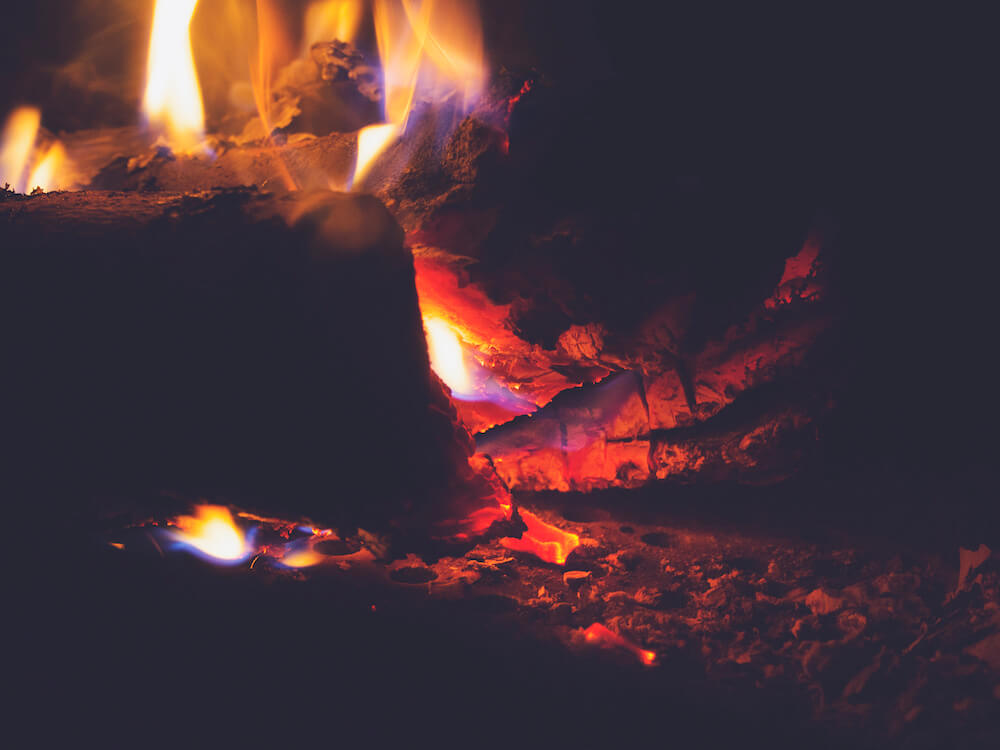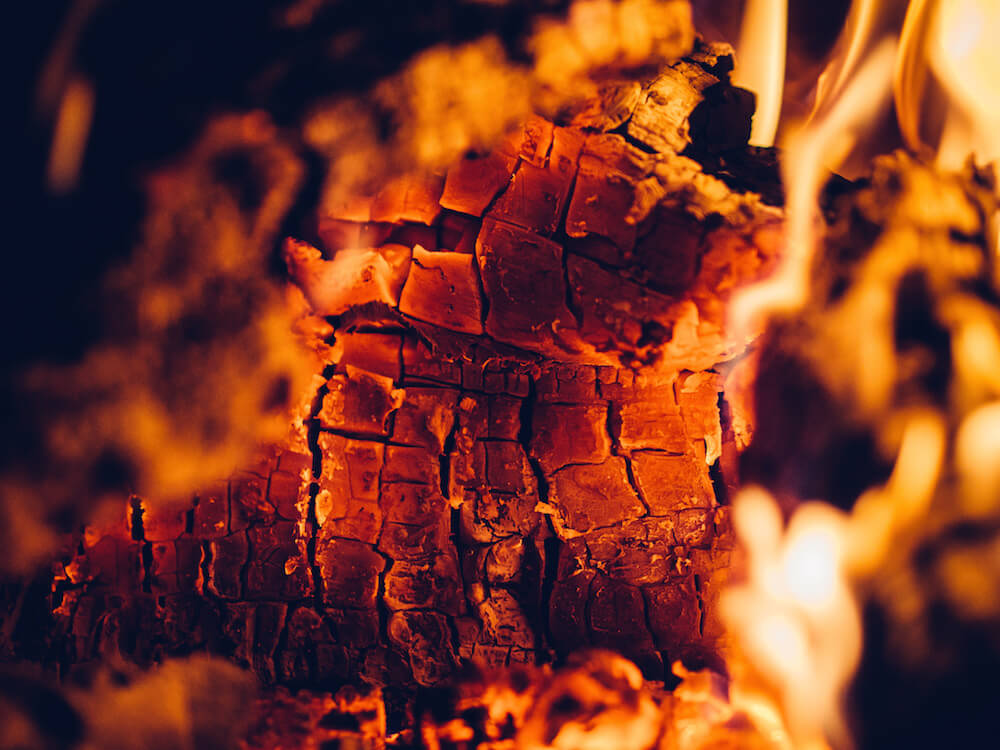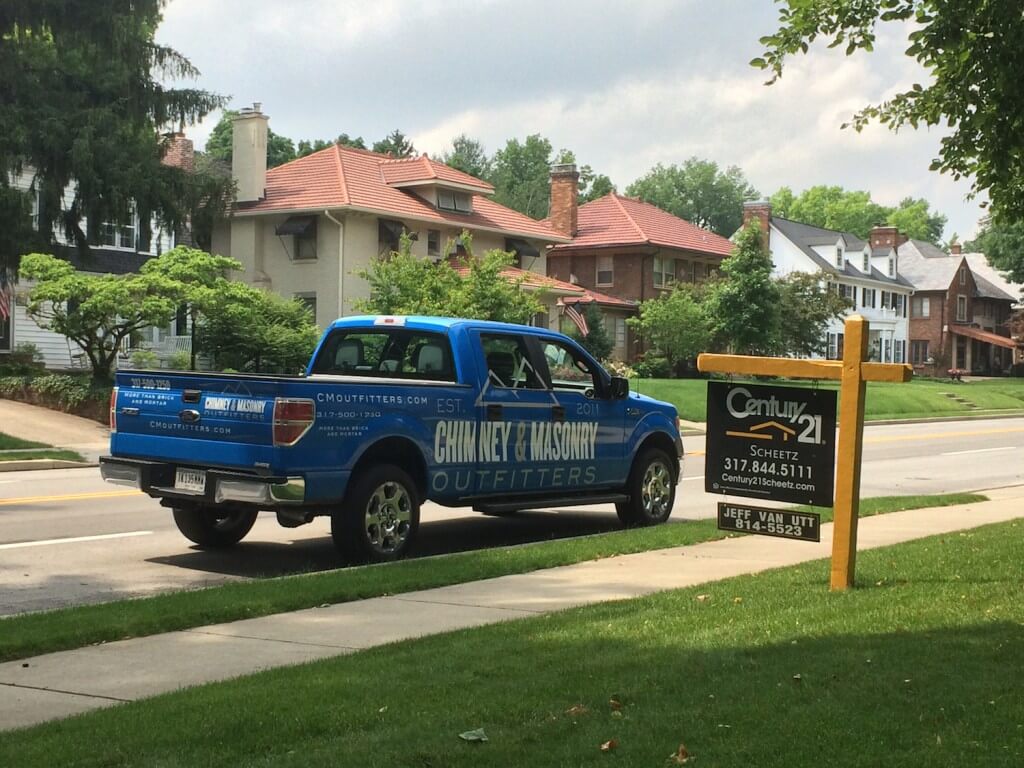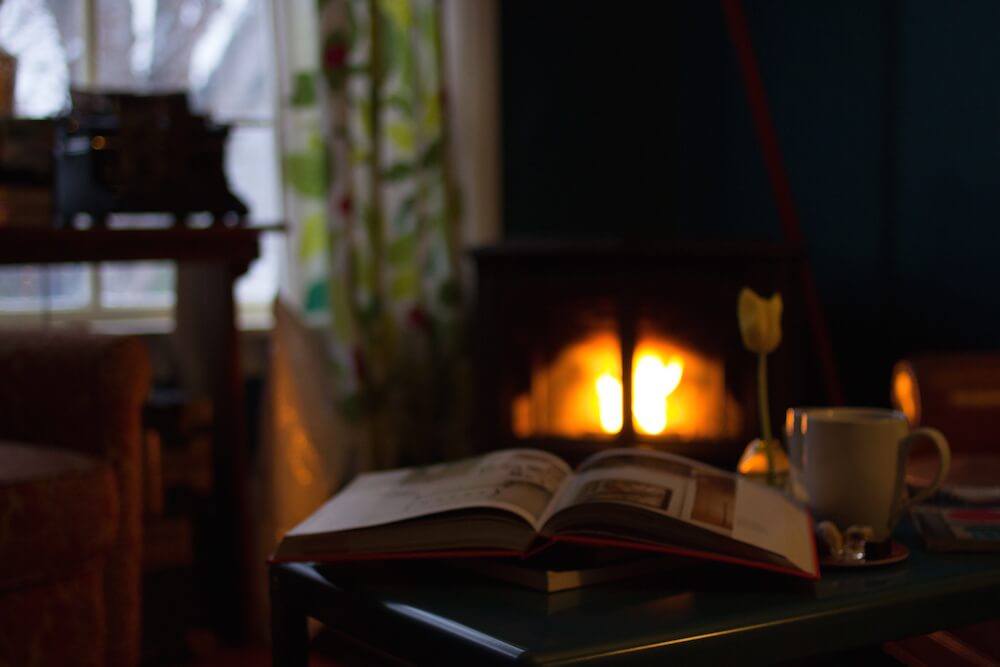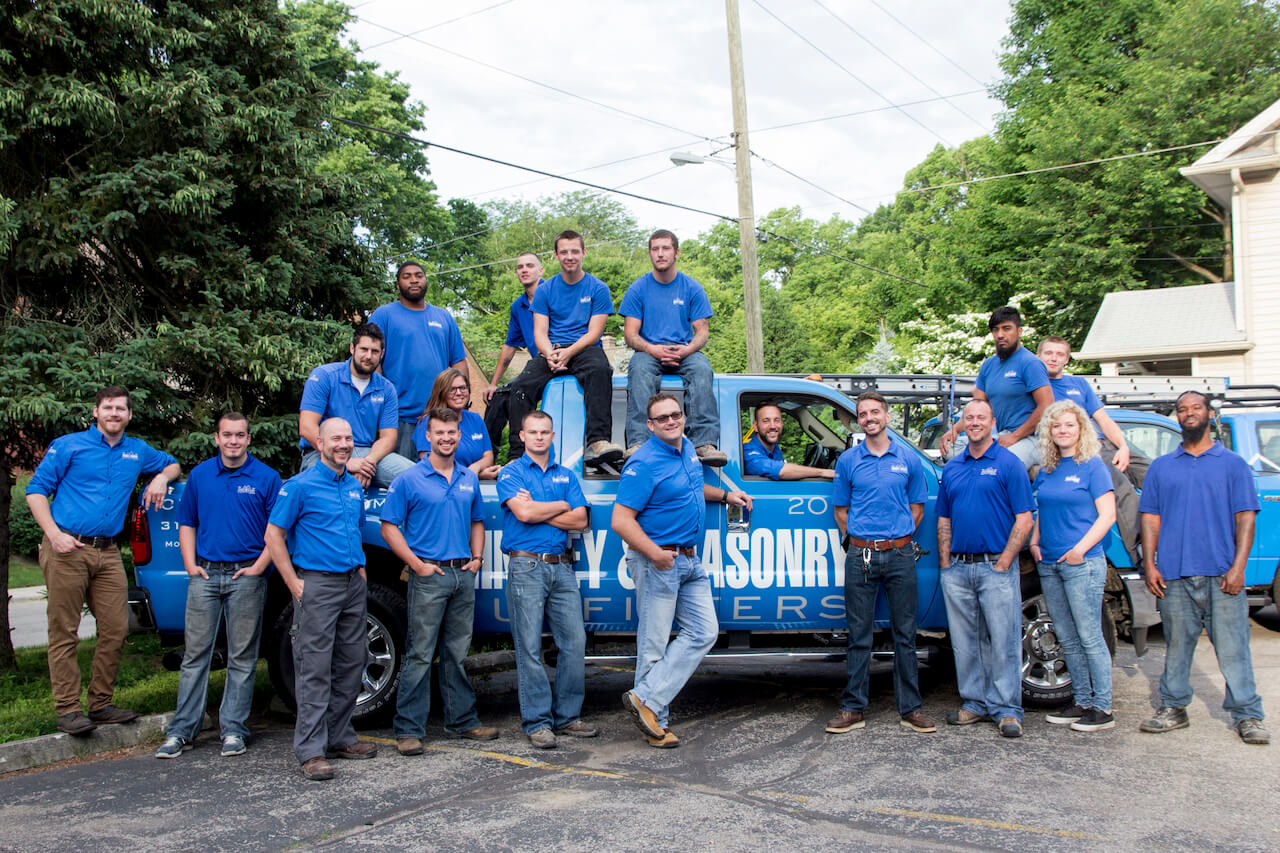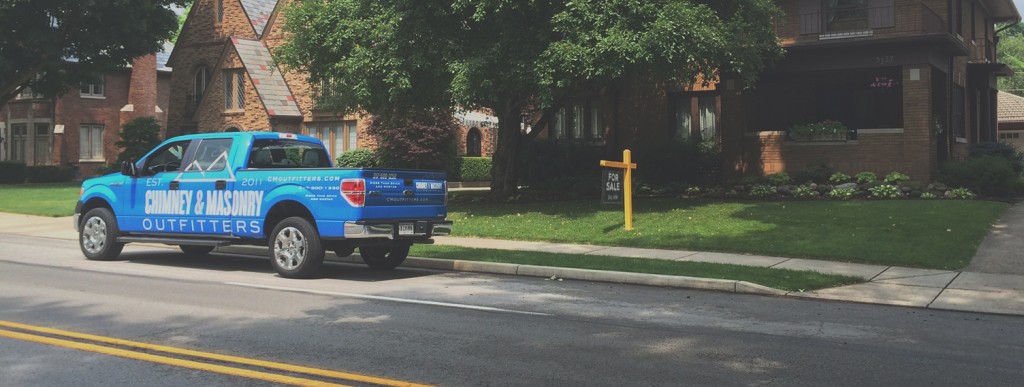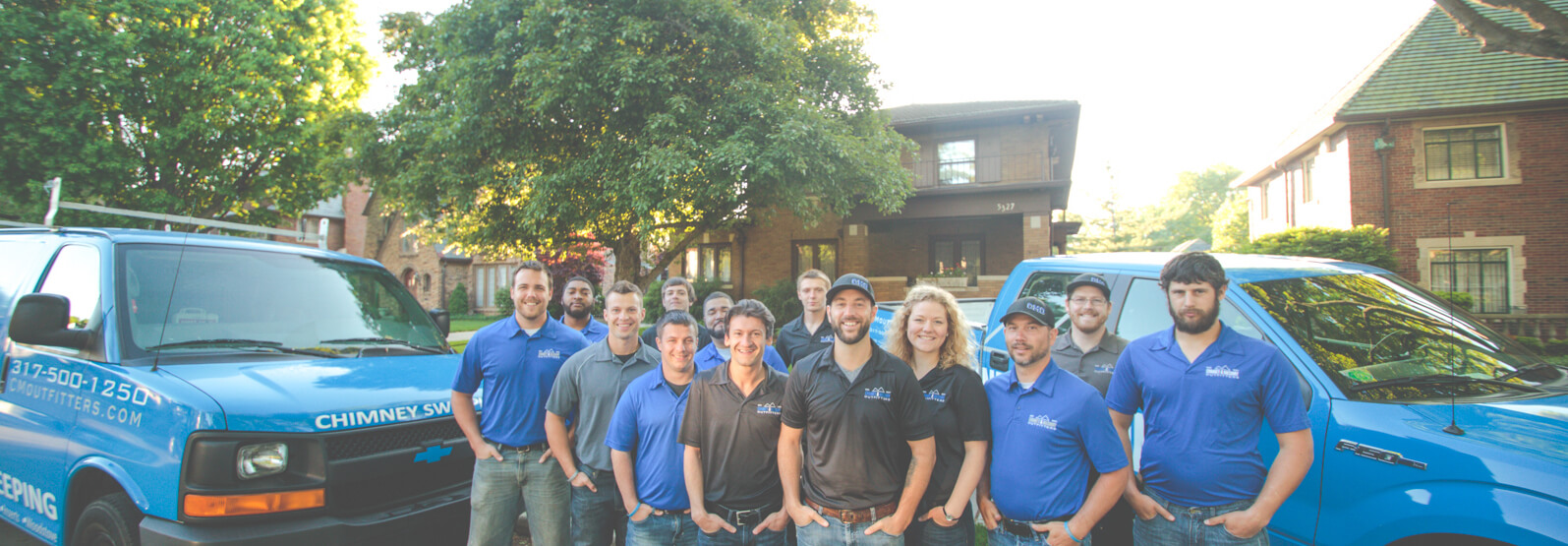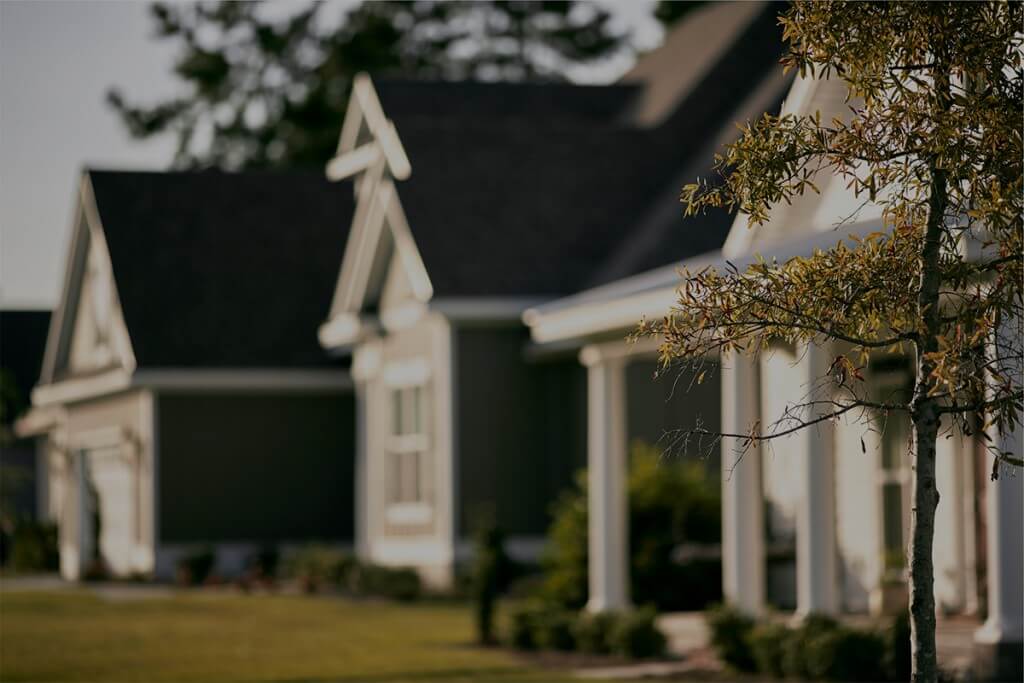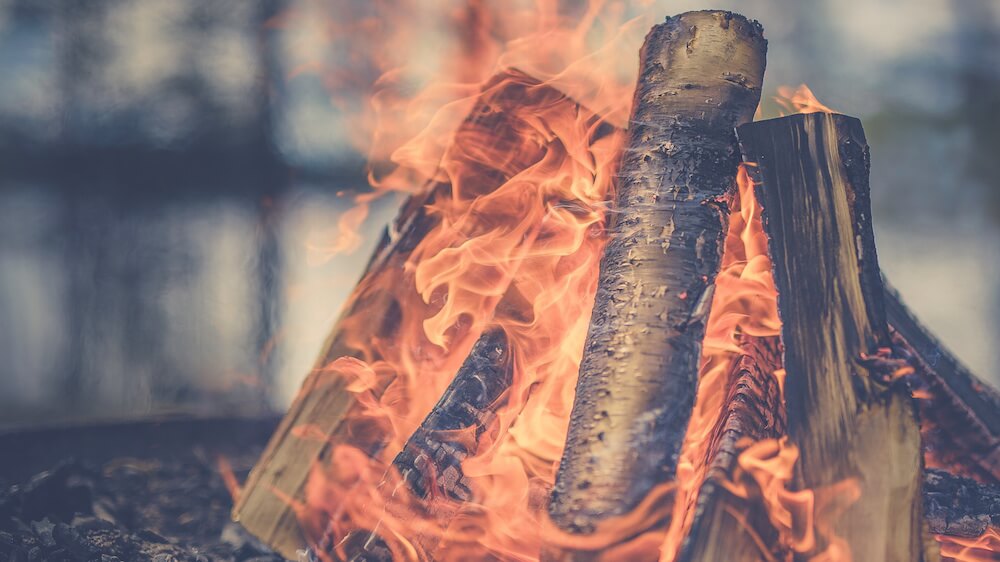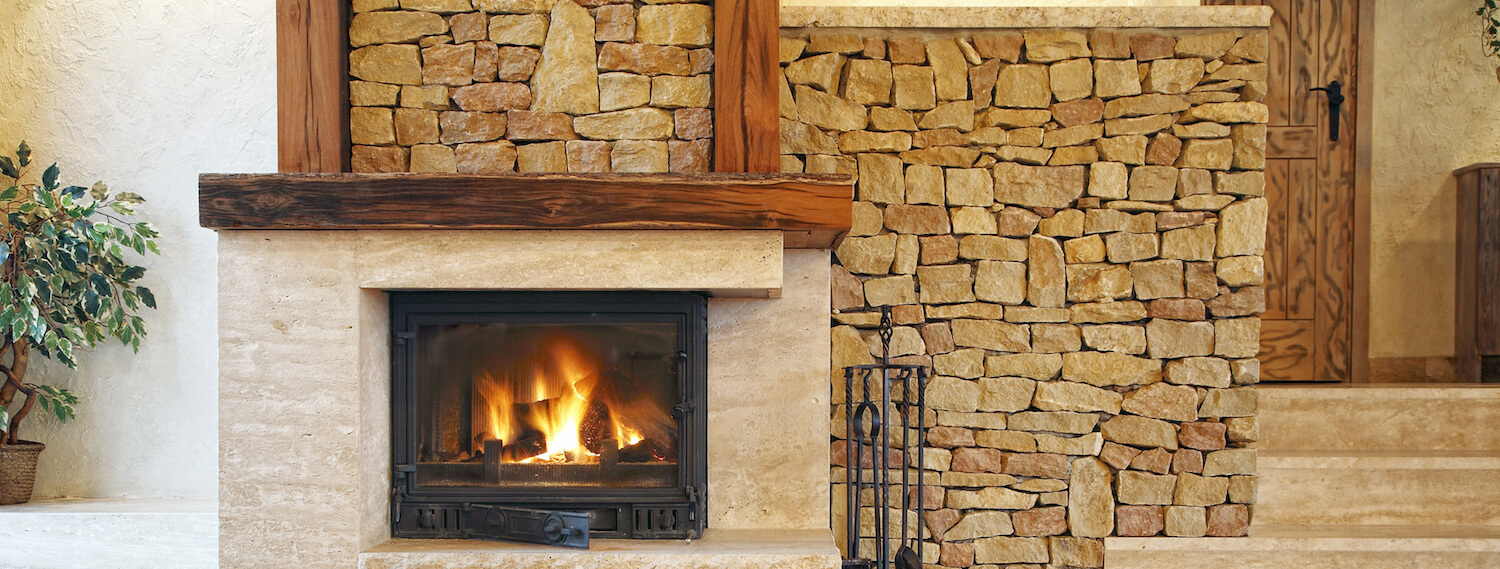Heating Your Flue Before Lighting Your Fire
Top tip: You can’t have a fire with a cold flue. Or rather, you can, but that fire will probably be quite smoky and difficult to sustain — and no one wants that. In our previous blog on “How to Get a Good Fire Going”, we touched on the importance of prepping your flue before starting your fire. Prepping your flue is crucial to establishing a good draft in your chimney system. We want to talk more in-depth about this preparation process to help ensure that you have a safe and pleasant fireplace fire experience.
Why Do I Need to Preheat My Flue?
Preheating your flue every time you light a fire is crucial to ensuring that air is cycling properly in your chimney system. When you are not operating your fireplace, the chimney is full of cold air (especially during the cold and damp winter months). This cold air is very heavy and essentially acts as a plug in your chimney. If you were to just light your fire without preheating the flue, the initial heat and smoke of the fire would be too weak to push the cold air out. The smoke will just take the path of least resistance and escape into your home. Instead, you want to warm up the flue first to push the heavy cold air out and start a draft cycle that will pull the smoke up and out of the chimney. Because, science.
So How Do I Do It?
The first step is to make sure that your damper is all the way open. Once you are certain of this, get set up to start your fire. Before you do so though, take a piece of newspaper (preferably paper without color or gloss) and roll it up. This newspaper will serve as a sort of “torch” that you will use to warm the flue. Once you have made a couple of these “torches,” light them and hold them high up in the flue area. The heat from the newspapers will be strong enough to push out the heavy cold air and establish a draft. If this method doesn’t work well for you, you can leave the damper open for about a half hour and allow the warm air in the room to push the cold air out. However, this method is less energy efficient than using the newspaper. No matter which method you use, you want to be sure that you feel the flow of air reversing and the warm air being sucked up into the chimney. Then, you are ready to build and enjoy your fire.
If you are preheating your flue but still experiencing smoky fires, there may be some obstructions or other issues in your chimney. It critical to have your chimney swept and inspected by professionals to avoid problems like these and other serious hazards, such as flue-fires or carbon monoxide leaks. Please don’t hesitate to give your certified Chimney Outfitters a call. We want you to enjoy a functional and safe fireplace.
How to Get a Good Fire Going
Although we’ve had some lovely glimpses of spring recently in Indianapolis, those warm sunny days are still being followed up by some bitter cold stretches. One moment it will be 70º degrees and sunny, and then suddenly it will drop down to a frigid 30º chill. Just when you think spring has finally sprung, winter rears its head again.
The perfect remedy for these lingering chilly nights is gathering around a good, roaring fire. Here are four essential steps for starting a strong fireplace fire to keep you nice and warm.
Step 1: Prep Your Fireplace
First, you want to ensure that your fireplace and chimney are clean. It’s important to keep up with your regular fireplace maintenance and have your chimney swept and checked at least once a year. Soot and creosote build-up in your chimney’s flue system could block airflow and create a smokier fire. Worse, obstructions potentially lead to chimney/flue fires or carbon monoxide hazards. For more information on the importance of chimney sweeping read our previous blogpost: The 3 Why's.
Then, you want to make sure that your damper is completely open (check for blockages) and prime the flue by warming up the air in your chimney. You need to ease the cold air out before lighting your fire, either by lighting the end of some rolled up newspaper and holding it up towards the damper or leaving the damper open for about half an hour to allow the warm air in the room to do the trick. Once you feel the flow of air reversing, you’re ready.
Step 2: Gather the Necessary Materials
Make sure you have everything necessary before you get started, namely: a screen, well-seasoned wood, kindling, paper and matches. It’s extremely important that all of your fuel is as dry as it can possibly be. It also might be helpful to arrange your wood and kindling by size so that you can build your fire more easily.
Step 3: Build and Light Your Fire
Recently we talked about the benefits of a top-down burn. A top-down burn helps create a more efficient fire while reducing the amount of smoke generated in the process, and we highly recommend trying out this method. Whichever method you use though, you should stack the logs and kindling so that there is space for air to get through the layers and fuel the flames.
Step 4: Nurse Your Fire
Building a strong fire requires care and attentiveness, especially at the beginning. You need to add more kindling and paper before that layer dies down until you are sure that the logs have caught fire. Even then, once you have a strong fire going, it’s important to add new logs when the others begin to sputter out and to poke the wood to keep air flowing. If you just pile on a lot of logs at once, there will be no room for airflow, and the fire will be stifled. Nurse your fire overtime so that you can enjoy a lasting blaze.
Start with these steps to make a strong fire that will warm you through this lingering winter. If you have any issues or questions, give us a call. Brick + Ember Outfitters is committed to the safety and functionality of your chimney and fireplace. We can set up an appointment for you to speak with one of our Outfitters who will address any of your concerns.
Buyers Will Pay More for These 10 Home Features
“Location, location, location” as the familiar real-estate adage goes. Well, as it turns out, the adage may need to be rephrased as “amenities, amenities, amenities.” According to a recent survey conducted by the National Association of Realtors (NAR), potential homebuyers are willing to pay more for (and possibly sacrifice some aspects of location for) certain home features.
Now, there are two important caveats to this. First, most homeowners who are most willing to pay more for these amenities fall within the 35-55 year age-range. While younger, first-time buyers are just looking to break into the market and build equity, these buyers are more likely to be invested their quality of life in and connection with the home. Second, although buyers say they are willing to pay more for these features, often they are not willing to pay enough to cover the actual costs — their eyes are bigger than their wallets.
Still, it’s a good idea to keep the following 10 amenities in mind when selling. One or more of them may be enough to convince a buyer to up their budget and make an offer.
1. Central Air Conditioning: 69% of homebuyers willing to pay an extra $2,520
A majority of people in all age groups emphasized the importance of central air conditioning and said that they were willing to pay more for it than any other feature except new kitchen appliances.
2. New Kitchen Appliances: 69% of homebuyers willing to pay an extra $1,840
New kitchen appliances are particularly important to those looking to buy a new home rather than a previously owned home.
3. Walk-in Closet in Master Bedroom: 60% of homebuyers willing to pay an extra $1,350
Buyers are looking for walk-in closets both as additions of space and as status symbols to be shown off on house tours.
4. Granite Countertops: 55% of homebuyers willing to pay an extra $1,620
Granite countertops are more of an aesthetic concern for buyers. Beautiful kitchens are incredibly desirable features for those looking to cook and gather in this central space.
5. Hardwood Floors: 54% of homebuyers willing to pay an extra $2,080
While many older homebuyers prefer carpet for its energy-saving and heat-insulating qualities, younger buyers are looking for hardwood, as it’s easier to clean and considered more aesthetically pleasing.
6. Ensuite Master Bath: 49% of homebuyers willing to pay an extra $2,030
This one goes along with the walk-in closets. Buyers are looking for master suites that feel like “getaways” or “sanctuaries.”
7. Kitchen Island: 48% of homebuyers willing to pay an extra $1,370
Kitchen islands have become more important to buyers as kitchens are increasingly used as casual, all-purpose gathering spaces for families and entertainment spaces for guests.
8. Stainless Steel Appliances: 41% of homebuyers willing to pay an extra $1,850
Again, stainless steel is more of an aesthetic concern for buyers who are focusing more on beautifully designed kitchens.
9. Eat-In Kitchen: 40% of homebuyers willing to pay an extra $1,770
Buyers with families are most concerned with having eat-in kitchens, while younger buyers are less concerned about this feature.
10. One or More Fireplaces: 40% of homebuyers willing to pay an extra $1,400
The survey speculates that, while fireplaces have always been popular, they may become more desirable as people spend less time watching TV. Buyers may find the fireplace a cozy place for gathering and using more mobile devices.
Unsurprisingly, buyers consider kitchens, bathrooms and closets extremely important features. However, there are some other structural amenities that are worth spending some time on. Capitalizing on a cozy fireplace as a selling point can help convince buyers make an offer — and perhaps spend a few extra dollars. And, as your Brick + Ember Outfitters, we advise getting a sweep inspection prior to selling so that you can market the safety and functionality (in addition to the coziness) of the fireplace.
Fireplace not Drafting?
Like anything that stops working, or doesn't seem to be working well - there is a myriad of reasons to consider.
For the sake of time, and space, we are going to consider a few for reasons your fireplace may not be drawing or drafting, well or properly.
We can start with a few less despairing considerations, because it may be a very simple issue to resolve:
Is the Damper 'Open' - all of the way?
Is the damper open at all? Frankly this is a far more commonly forgotten step than the folks in your home may be giving you grief about, and we have all certainly been there. Make sure the Damper is open all of the way prior to lighting the fire. Your damper could be jammed due to soot or creosote that has built-up behind the damper.
Is the House too air-tight?
A fireplace needs a bit of a draft to pull up and out of the chimney in order to get the fire enough oxygen to burn efficiently. With updated windows and doors, a house may be quite air-tight, which until the fireplace is utilized, is a very ideal situation. However, cracking a window or two when utilizing the fireplace will allow the fire to burn more efficiently and less smokey.
The chimney's flue is dirty?
If your chimney has not been cleaned, and you are new to the fireplace-sphere, utilization of the chimney guarantees creosote to be a by-product that builds up in the chimney's flue system. The chimney sweeping industry recommends an annual cleaning, if not more, depending on the amount of burning that occurs in the fireplace. If there is build up in the chimney, there will be more resistance for the air-flow and thus, like mentioned above, your fire will not burn efficiently and you could experience a smokier fire - not ideal.
The chimney's design?
This list can get quite extensive because the design issues of a chimney can have a huge effect on the efficiency, and quality of the burn. Flue not tall enough? Flue not large enough or small enough for the the size of the firebox (the space in which the fire takes place)? Is the chimney straight up, and are the flues properly aligned inside of the chimney? And the list goes on.
Start with the first few tips listed for why the chimney may not be drafting or drawing properly, but do not just despair about it - Brick + Ember Outfitters is committed to the safety and functionality of your chimney. Give us a call and let us know what you are hoping to get out of your chimney's function, and we will get you an appointment to speak with one of our Outfitters about how to best address any issues or concerns.
Meet Michael!
Meet Michael: B+E's Outfitter of the Month for February

Welcome to 2017!
Trends are trends and always will be, but we wanted to give you a quick look into what we have seen coming up for 2017!
CBS Money Watch gave us some tips that aligned with a couple of other sources on what to expect in 2017 Real Estate Trend.
Here's the skinny:
Millennials Will Be Your Buyers:
As far as the housing market is concerned, we are looking at the millennials headed in for their first-home purchases. But they aren't looking for the temporary home, this is a bougie (desiring up-scale) group of young adults, who are typically waiting a little longer to get married/ have children, so this first home has a lot of stipulations attached to its purchase.
Housing Values will Increase - Slower:
While the housing market has been in recovery for quite some time, the value of homes is still on the rise, but it is predicted to slow a bit. According to CBS Money Watch, last year's growth was a 4.8% value increase while 2017 is showing an expected 3.6% value increase. Please also note that our government will likely undergo changes in light of the recent election and the market absolutely has the potential to reflect those factors - we may not see much this year, but it is never bad to be mindful!
Suburbs are Affordable:
While the cities are extremely desirable places to live, it has become more expensive to live in the city than to look out in the suburbs - it is just more affordable. We also read recently that suburbs are taking on a bit of a new phase as they are reflecting these mildly self-sufficient nucleus which often include other desirable amenities - we immediately thought of West Clay in Carmel, Indiana. This place has a town hall, numerous pools and club-houses, not to mention there are shops, a dentistry, and a handful other conveniences within the sphere of this extensive housing development.
Building A New Home will Be More Expensive:
Due to the construction industry's labor shortage the cost of building a new home is going to be a bit more expensive - competitive costs of labor, will mean that the weight of those costs will be bore by the consumer. This is where the decisions of the new President Elect will have an effect on our markets going forward - here we go!
Midwest Cities & Millennials:
Apparently there may be an influx of millennials moving to the following Midwest cities, according to Realtor.com; Madison Wisconsin; Columbus, OH; Omaha, Nebraska; Des Moines, Iowa; and Minneapolis, Minnesota. These cities are located near major higher education institutions and offer easy transition into well-paying jobs and housing.
The West-Coast is not Getting Cheaper:
However, as stated by CBS Money Watch's article, "population growth will follow job growth." This trend doesn't need much clarity - it's expensive to move out there, but job growth will still draw folks out to the West Coast.
City Infrastructure Development (Smaller Homes):
Affordable housing in cities is always a point of contention - but consider how it is being addressed in many markets: smaller housing = more affordable housing. We are seeing smaller housing going up to confront the issue and provide options for those who live in the cities.
Affordable Rent Options:
This one is a bit two fold. While experts predict that rental rates will rise only 1.5%, more multi-family rentals are being built and in addition to this, renters are settling in with roommates to alleviate the cost-of-living.
Mortgage Rates will Rise Again:
As our economy has continued to pick back up through the years, the housing market has followed suit - however, according to CBS Money Watch, we will see the mortgage rates begin to increase as the Federal Reserve indicates increases in its benchmark rates.
Now, we know this doesn't necessarily have a direct correlation to chimney or masonry work, per se, but we have sought to bring you the foreseeable trends for the upcoming year, regarding the Real Estate industry, so that you are best prepared to know who to go to for what, when. Prior to selling or buying a Sweep & Camera Inspection is never a bad idea, and could prevent you from looking quite un-ideal as the agent, in whom your client's trust is found.
Seeing these trends will hopefully get you in a position to ensure your ducks are in a row, making you more agile for the changing market.
Meet Troy!
Meet Troy: B+E's Outfitter of the Month for January!
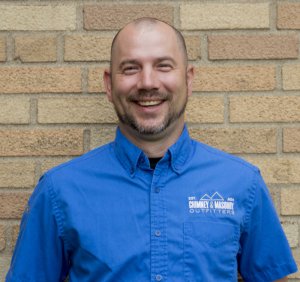
2017 Home Show
From all of us here at Brick + Ember Outfitters, A Happy New Year to our Indianapolis Homeowners!
2016 looked like quite the mixed review from the social media sphere, so we wondered if you might be looking for a little inspiration to get going this year - most specifically, with the home-projects and your home's tough love and care for 2017.
The Indianapolis Home Show is just around the corner, and we would love to see you there, finding all of the inspirations!
The Details:
The Home Show is: January 20-29, 2017 at the Indianapolis State Fairgrounds
(West Pavilion, Exposition Hall & South Pavilion)
- Brick + Ember Outfitters will be located in Booth 245
- Brick + Ember Outfitters has up to $15,000 worth of giveaways - from Chimney Sweep (including camera inspection) valued at $199 to a Fireplace Hearth Restoration Credit valued at $6000 and a few things in between. That is some serious giving away!
Note: If you cannot make it to the Indianapolis Home Show 2017, Brick + Ember Outfitters wants to make sure you have an opportunity to grow some peace of mind for your home this year:
Enter to Win B+E's Homeshow Giveaways by texting "Chimney" to "31996"
Established in 2011, Brick + Ember Outfitters has been committed to building equity, restoring beauty, and growing peace of mind when it comes to the chimney and masonry work of your home.
Have A Fireplace? Consider 5 Tips to Keeping the Heat In Your Home:
We recently talked about the positive implications of burning a top-down burn, but if you own a home with a fireplace-chimney, you will want to make sure that you are keeping any and all heat inside of you home after you have enjoyed the fire.
Here are 5 ways to maximize the amount of heat being kept in your home:
- Remember to shut the fireplace damper when the fireplace is not in use. The damper is designed to create a draft - leave it open and it will do its job - drawing air up and out of the home. We recently came across a home in which the damper was unable to be shut due to a blockage - talk about wasting hot air.
- A Heat-Air Exchange could be installed, in addition to a glass door front. The Heat-Air exchange is designed to send the warm air back into the room.
- Ensure there is no draftiness around the seals of your fireplace damper. As we stated before, the damper is designed to create a draft when opened, but if it is closed and not well sealed, you will run into the same issue as before - loss of the warm air in the home.
- Consider insulating your chimney. A chimney liner may increase the life of a chimney as the gases created during combustion are extremely acidic, eating away at the mortar joints of a standard ceramic flue system. According to the Chimney Safety Institute of America, a liner system can also protect from the transfer of combustibles into other structural components of the home. “In the NBS tests, unlined chimneys allowed heat to move through the chimney so rapidly that the adjacent woodwork caught fire in only 3 1/2 hours” (CSIA).
Always have your chimney cleaned and inspected annually by a certified chimney sweep (CSIA). A chimney sweep, certified by the CSIA has received education and training to address and ensure the components of your chimney's venting systems are functioning safely and efficiently within your home.
If you own a home with a gas burning fireplace, not only are these tips extremely important, but a critical consideration in addition to reducing the loss of heat in your home is to also consider the safety of having a gas-burning appliance running inside of your home (furnace included). Carbon monoxide is a tasteless, odorless gas that is extremely dangerous to have trapped inside of a home. Your CSIA certified sweeps are trained to address the necessary drafting of these appliances (included the fireplace) for optimum safety and efficiency, of these appliances.
If you have any questions about these tips, do not hesitate to reach out to us here at Brick + Ember Outfitters. All of our Sweeps have been certified by the Chimney Safety Institute of America. At B+E, we are committed to the safety and functionality of your chimney venting systems.
Want to Burn Efficiently? Here's a Tip:
A Top-Down Burn!
Here is what we know: starting a fire from the bottom of the wood 'arrangement' can actually generate a ton of unwanted smoke, and then there is that moment when you realize all of that huffing and puffing is not really encouraging the flame to ignite, and - okay, yep - the fire has gone out.
Why not increase efficiency and reduce the amount of hyperventilating you would otherwise need in order to get the fire started - you know, save your breath.
A top-down burn has been used for centuries, but may a new concept to you so we wanted to give you the run-down.
Here's how it works:
- Step 1: Organize your firewood pieces, largest to smallest.
- Step 2: Place the largest pieces on the bottom of the rack/firebox-floor - the ends of the firewood should run from the front to the back of the firebox (stick your arms straight out in front of you - they should run that direction)
- Step 3: Continue piling more levels of fire-wood, obviously the size of the firewood needs to be decreasing as you build (5 levels up is plenty - a couple more if your firebox is larger).
- Step 4: The kindling at the top - the, dryer, more ignitable wood/kindling will be necessary here - you need this wood to get the fire going and to continue to heat and ignite the wood below (the Chimney Safety Institute of America suggests this be wood that can be lit by a single match).
- Step 5: Get those kindling/small pieces of wood lit, and now you have a top-down burn to enjoy!
The wood used in your fireplace should always be well-seasoned fire wood.
At Brick + Ember Outfitters it is our goal to provide you with a peace of mind when using your chimney's fireplace. Please adhere to the industry standard of having your chimney (both fireplace, and furnace flues) cleaned and inspected at least once annually. In addition to this, utilizing the top-down burn will improve the efficiency of your burn for the enjoyment and heating of your fireplace.
Haven't had the chimney cleaned or inspected yet this season? Give us a call (317) 500-1250 or visit us at B+EUTFITTERS.COM

